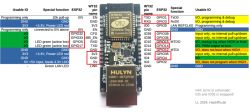Welcome,
I would like to find out more about the topic of "smart homes", or rather I would like to find out more about sensors and actuators.
I want to set up a smart home installation from scratch. I would like to write the application itself, which controls the house, so the actuators/sensors should use some known, popular way of communication. To begin with, I would like to be able to control the lights and roller-blinds at home using (wall) switches and an application (i.e. remotely). In addition, I would also like to have motion detectors in the rooms. Of course, I want to communicate with the actuators/sensors directly and not via the manufacturer's server for these devices. These devices are to be disconnected from the internet.
It is important to me that the communication standard is secure, easy to use and popular (so that it will not be extinguished anytime soon). In addition, it is also important that all these devices can be removed (from the boxes) if necessary and the installation can be rewired (without ripping up the walls) in such a way that it can work without these devices using standard light switches.
It is important to me that the workmanship and safety of the devices themselves are not in question.
The devices themselves should work with mains voltage.
The question that comes to my mind is whether to use wired or wireless controllers (if wireless, in which communication technology: Z-Wave, Zigbee or WiFi). Are there any devices that use wired Ethernet or CanBus protocol? Does anyone have any suggestions as to brands of controllers or specific devices that meet the above requirements? Or does anyone already have this dilemma behind them and would like to share their knowledge on the subject?
I am also considering the possibility of designing my own devices, but this is a last resort that I would prefer not to use.
I would be very grateful for any information.
Best regards.
I would like to find out more about the topic of "smart homes", or rather I would like to find out more about sensors and actuators.
I want to set up a smart home installation from scratch. I would like to write the application itself, which controls the house, so the actuators/sensors should use some known, popular way of communication. To begin with, I would like to be able to control the lights and roller-blinds at home using (wall) switches and an application (i.e. remotely). In addition, I would also like to have motion detectors in the rooms. Of course, I want to communicate with the actuators/sensors directly and not via the manufacturer's server for these devices. These devices are to be disconnected from the internet.
It is important to me that the communication standard is secure, easy to use and popular (so that it will not be extinguished anytime soon). In addition, it is also important that all these devices can be removed (from the boxes) if necessary and the installation can be rewired (without ripping up the walls) in such a way that it can work without these devices using standard light switches.
It is important to me that the workmanship and safety of the devices themselves are not in question.
The devices themselves should work with mains voltage.
The question that comes to my mind is whether to use wired or wireless controllers (if wireless, in which communication technology: Z-Wave, Zigbee or WiFi). Are there any devices that use wired Ethernet or CanBus protocol? Does anyone have any suggestions as to brands of controllers or specific devices that meet the above requirements? Or does anyone already have this dilemma behind them and would like to share their knowledge on the subject?
I am also considering the possibility of designing my own devices, but this is a last resort that I would prefer not to use.
I would be very grateful for any information.
Best regards.





